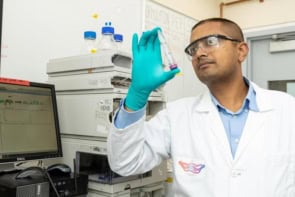
Far ultraviolet-C light can reduce the level of airborne microbes in a room by more than 92%, according to a new study by researchers in the UK and the US. The result suggests that lamps operating at this wavelength could be used to combat common airborne viruses, including SARS-CoV-2, and thus prevent the transmission of diseases like COVID-19.
While ordinary UVC light is very effective at destroying microbes like bacteria and viruses, it is hazardous for humans because it can damage skin and eyes. A decade ago, researchers at Columbia University in the US discovered that a different wavelength of UVC light, known as far-UVC light, would be just as effective at killing germs, but without the safety concerns. This is because, at 222 nm, its wavelength is too short to penetrate human skin or eye cells. These early tests of the technology were, however, conducted in small experimental chambers, rather than room-sized ones that better reflect real-world human environments.
Testing far-UVC krypton chloride excimer lamps against S. aureus
In the new work, scientists from the universities of St Andrews and Leeds in the UK and Columbia University Vagelos College of Physicians and Surgeons tested the efficiency of far-UVC krypton chloride (KCl) excimer lamps in a specially designed room-sized chamber at Leeds. The researchers ventilated this chamber at the same rate as a typical home or office – that is, around three air changes per hour. They then released aerolized S. aureus bacteria into the space continuously, allowing the pathogen load to reach a stable level before sampling the air for an hour.
While continuing to release the aerolized S. aureus into the chamber, the researchers then switched on the far-UVC lamps placed on the ceiling of the chamber and sampled the air for a further hour. “This methodology allowed us to compare the air samples after the lamps had been switched on compared to the air samples before lamp switch-on,” explains team member Kenneth Wood, a researcher in the School of Physics and Astronomy at St Andrews.
The team found that the lamps reduced the continuously produced aerolized S. Aureus pathogen load in the room by 92%, which is equivalent to 35 air changes per hour. “This is exciting,” Wood tells Physics World, “since this is a higher number of air changes per hour than other technologies (which have been limited to 5 to 20 equivalent air changes). It is also the first time the effect of far-UVC has been demonstrated for aerolized pathogens in a large ‘real-world’ type environment.”
“Spectacular results”
Wood adds that the trials have produced “spectacular results”, far exceeding what is possible with ventilation alone. “In terms of preventing airborne disease transmission, far-UVC light could make indoor places as safe as being outside on the golf course on a breezy day at St Andrews,” he says.

The potential of far-ultraviolet light for the next pandemic
Team member David Brenner, who leads the Center for Radiological Research at Columbia, says that far UVC-light should be just as good at inactivating current and future variants of SARS-CoV-2; new infectious viruses that have yet to emerge; and “old-fashioned” viruses like influenza and measles. The researchers foresee that far-UVC could become an important “hands off” tool, alongside filtration and ventilation, in a global move towards reducing airborne transmission of disease and improving indoor air quality.
The team have received funding from NHS Scotland Assure to investigate the impact of far-UVC when there are different mechanical ventilation rates. “With this funding, we also plan to study how far-UVC acts on other pathogens and hopefully short-distance viral inactivation,” Wood says. The researchers would now also like to test the technology in real-world environments.
The research is detailed in Scientific Reports.



